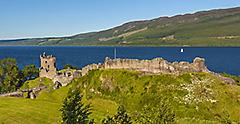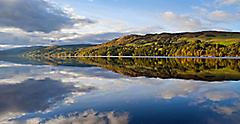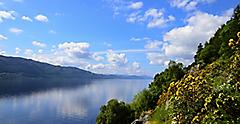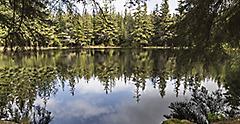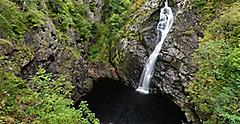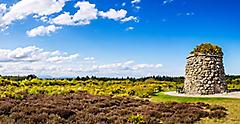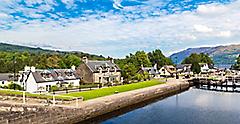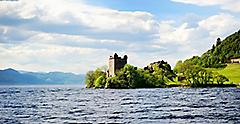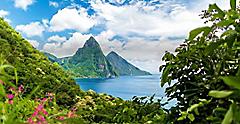By Hayley Simpson | Published on February 9, 2024
Loch Ness And Its Mysterious Monster
Located in the scenic Scottish Highlands, Loch Ness is a lake that holds the United Kingdom's largest volume of fresh water. In fact, it has more water than all the lakes in England and Wales combined. At 23 miles long and deeper than the North Sea, its outlet is the River Ness, flowing into Inverness' Moray Firth. Loch Ness is one of four lochs located on the Great Glen, a glacier-carved valley created during the last Ice Age. Underneath is the 400-million-year-old Great Glen Fault, which can be seen from space. Loch Ness is known for being dark and deep — perfect conditions for a mysterious monster.
The Loch Ness Monster, nicknamed Nessie, is a mysterious water creature that, according to Scottish folklore, has inhabited Loch Ness since ancient times. The first written account of Nessie's activities dates back to 565 A.D. in St. Columba's biography. St. Columba wrote that a monster bit a swimmer, and he ordered it to "go back."
In 1934, English physician Robert Kenneth Wilson captured the alleged monster in an iconic image titled the "Surgeon's Photograph," which shows its small head and neck protruding from the water. It became an international phenomenon when printed in the Daily Mail. Based on the photographic evidence, many believed it was a plesiosaur, a marine reptile made extinct over 65 million years ago. For decades, the photo fed into the legend of the Loch Ness Monster. However, in 1994 it was revealed the photograph was a hoax created using a dinosaur head and a toy submarine.
In 2018, a DNA survey of Loch Ness revealed the presence of numerous eels but no other large animals. So, it's possible that the "real" monster is just an oversized eel. Still, the story of the Loch Ness Monster continues to draw curious visitors from around the world. In the early 2000s, Loch Ness tourism contributed nearly $80 million to the Scottish economy.
Pick Your Perfect Loch Ness Adventure
So, you want to go hunting for the mysterious Loch Ness Monster yourself? Well, you can do that and so much more when visiting Loch Ness on Scotland vacations. Loch Ness is one of those rare destinations that has something for everyone. Children will be enchanted with stories of Nessie, photographers will have a field day capturing the stunning scenery and history buffs will love learning about the loch's rich history.
When visiting Scotland, a Loch Ness cruise is one of the most popular water activities, where you can soak in the scenery while listening to legendary tales. If that's not enough and you want to get a little closer to Nessie, hop in a kayak and glide across the lake, keeping your eyes peeled. Loch Ness is a part of the Great Glen Canoe Trail, an ancient route through iconic Highland scenery that runs from Fort William to Inverness, offering stunning views. You can also fish in the Oich, Moriston, and Ness rivers. While Nessie might not nibble on your line, you may catch a large spring salmon instead. The bravest of travelers may choose to swim with Nessie in the 41-degree water. The loch remains at this temperature year-round and refuses to freeze. Head to either Loch Ness or Lochend Beach for easy access.
If you'd prefer to stick to the shoreline, enjoy the Loch Ness 360° Trail, an amazing trail looping the loch that connects to the Great Glen Way and the South Loch Ness Trail. Don't miss Suidhe Viewpoint, one of the trail's highest viewpoints with unspoiled vistas. Another cross-country route for walkers and mountain bikers alike is the Affric Kintail Way. For a more peaceful stroll, try the Three Lochs Circuit through south Loch Ness' tranquil countryside. Or, hike up Meall Fuar-mhonaidh for the highest point near Loch Ness at 2,293 feet high.
From there, lovers of all things history will want to make a beeline for nearby Culloden Battlefield, where the Jacobite army stood for their final battle. If you're a fan of the television show Outlander, the region's real-life Fraser clan is primarily buried at Boleskine Burial Ground in Inverness. You can also channel your inner Claire Fraser and walk through an ancient circle of standing stones at Corrimony Chambered Cairn or Clava Cairns.
When it's time to refuel after a day of exploring the Scottish Highlands, cozy up by the wood-burning stove at Loch Ness Inn while indulging in modern fare made using local produce. Try Haggis meatballs, a Highland beef burger or Scottish salmon. Alternatively, enjoy the view from Cameron's Tea Rooms and Farm Shop or if you're a gin lover, the Great Glen Distillery is the place for you.
If traveling to Loch Ness with young children, Nessieland is a mini theme park with several Nessie-themed attractions suitable for young kids. However, adults may also enjoy getting a selfie or two with the giant Nessie statues.
What To Know Before You Go To Loch Ness
Since it stretches all the way from Fort Augustus to Inverness, a day trip to Loch Ness from Inverness is one of the most common ways to see the lovely loch. Wondering how to get to Loch Ness from Inverness? It's approximately a 15-minute drive, an 8-mile cycle, or a quick public bus ride to the neighboring towns of Dores, Inverfarigaig and Foyers — with stunning sights of the Scottish Highlands along the way. You can tick a lot off your list on your own in one day or if you join a guided tour. Alternatively, if you want to learn more about the history of this area, you can book a guided Loch Ness tour from either Glasgow or Edinburgh.
If you cruise to Scotland, it's easy to base yourself in Inverness, or in one of the many quaint towns on the shores of Loch Ness. On the western shore of Loch Ness, Drumnadrochit is a peaceful village lined with whitewashed cottages and home to the Loch Ness Centre and Exhibition. Here, you can learn more about Nessie and the region's history through seven themed rooms. The staff will also happily answer any and all questions, and the gift shop is stocked with all of your Nessie souvenir needs.
Get Royal Deals, Sign Up Today

Getting There
Explore Our Most Affordable Itineraries
Loch Ness is waiting for you when you cruise to the British Isles.
Related Articles

Family Cruise Activities on Ovation of the Seas
READ MORE
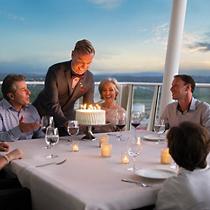
Cruises are the Best Birthday Weekend Getaways | Royal Caribbean Cruises
READ MORE

10 Galveston Camping Tips | Royal Caribbean Cruises
READ MORE
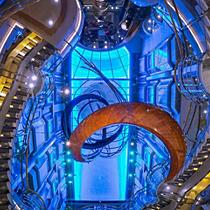
Free Things To Do Onboard Explorer of the Seas
READ MORE

